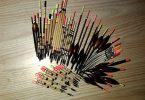In October 2000, Steve Randles started a new thread on the Anglers’ Net forum when he asked:
‘Why is it that at dusk, the wind drops and lakes end up calm like mirrors?‘
My reply revealed considerable interest in the explanation for the familiar everyday weather related phenomena that affect us as anglers, and I was begged to write a more comprehensive article. I agreed, not knowing then how much I had taken on in other directions, and how little time I had left myself for doing what I love best, after fishing. That’s writing about fishing.
Well, I’ve finally managed to snatch some hours at the start of some days, before the rest of the house awakes, and the following is the result. I hope that you find it has been worth the wait.
The day begins
Near the equator, the sun beats down from a cloudless sky; the blazing rays heating the cracked earth to scorching point. As the ground warms, the heat rises, transferring to the air above, and warm air rises up from the baked earth.
As the warmed air rises, it cools, and the moisture it contains condenses to form clouds, spectacular in glowing whiteness.
The process of condensation releases the heat used to evaporate the water, far away, when the warming air was in another place, above an ocean.
The air, warmed by the hot ground and cooled a little as it rose high, is warmed again by the release of the latent heat of evaporation, and warmer now than the air around, continues to climb higher still.
Air that rises must be replaced, some by cooler, denser air coming down from above.
But as the sun driven process moves into high gear, and the clouds and columns of rising air punch higher and higher, as the hot day progresses, air is sucked in from cooler latitudes to take the place of the climbing air mass.
The weight of the risen air, added to the air that is sucked in beneath to replace it, begins to form a high- pressure dome. At the same time, air pressure drops where the air has been taken to replace the rising air.
There, a depression begins to form in the earth’s atmosphere.
As the Earth turns, and the sun begins to go down, the process of solar heating subsides and the tower of air begins to cool and press down, forming an area of dense high pressure, trying to spread back and to fill the low pressure areas created by its birth.
But the earth spins and causes air moving across latitudes to spin in a whirling circle, moving away from the equator toward the poles.
So, this is how our weather systems are born.
Large stable areas of high-pressure, slowly spinning counter-clockwise as they journey northward (those going south spin clockwise). Smaller, more intense areas of low pressure, racing round the high pressure systems, sucking up moisture and forming weather fronts as they spin clockwise on their northern journey.
After a Summer’s Dawn
It’s 6am and I’m driving toward the lake on a misty late summer morning.
High above, air from a high pressure system tries to flow toward the area of low pressure, but because of the physics of the spinning earth and moving air masses, succeeds only in travelling around the centre of low pressure, along the lines of equal pressure known as isobars.
At ground level the air is still and undisturbed.
Just as a slow river flows sluggishly toward the middle, yet moves hardly at all toward the banks, providing relief from the flow for the growing fish-fry, so the air close to the ground is braked almost to a standstill by the surface of the land.
And the mist that rose from the warm dampish ground, as the heat of the soil drained away toward the stars overnight, still hangs over the ground like a ghostly blanket, flowing between the leaves of trees and bushes, leaving a morning dew to coat everything. Rainbow jewels on spider webs, rainbow jewels hanging from green leaves, and from dampened twigs and branches.
The rays of the early morning sun, tinged with red, pierce through the mist, cutting the whiteness with mysterious shadows of dewed trees and bushes. The last calls of the morning chorus drift to a silence.
Not many people are awake to see the primeval phenomenon. Only a few who need to be up to prepare the world for the start of a new day, and the lucky angler too, there by choice. Excited at the prospect of fishing a windless lake and filled with joy at the sight of a new day being born in mist and shadow, and the passing jewels of morning dew.
At the lake, the mist still rises from the water in ghostly wraiths, and the lake itself is hidden in the clouds of mist. The surface is a perfect mirror, fading into a white eternity, disturbed sometimes by a rising fish.
All I want to do, is to stand and stare, knowing that this beauty is a vanishing thing, and will soon be gone.
But another ripple disturbs the water, the sound being dulled by the mist, yet amplified in some strange way too. The edge of the weed bank moves as the fish pushes its way through.
There’s so much to do. Unpack the tackle, lay out the landing mat, screw net to handle, join the sections of rod and select and attach a reel, thread the line and choose a float…………….
Ready now to cast the baited tackle toward the weed bed’s edge, the ghostly shapes of trees along the far bank can at last be seen, just. But still the mist wraiths rise and dance above the water, not so many now, and now not rising so tall.
Yet still the water is still like a clouded mirror, dappled occasionally by the weal of a moving fish, and the wake of a clucking coot.
And the sun, it’s higher now. Smaller and brighter. But even now, I feel the slight warmth of its strengthening rays. It’s going to be a hot one.
The lake, like the air above it, is still. And not just on the surface.
With no breeze to ripple the surface, or to drive an undertow, no sun to heat the shallows and stir the waters, the lake slumbered through the night, the water stratifying into temperature zones, warmest at the top, coolest toward the bottom.
And the creatures of the lake found their way to the temperature zone that suited them best. And the larger creatures followed the preferences of the food creatures, so that much of the life of the lake gathered together and apart as though sorted by some mysterious force, like a child playing a sorting game with coloured beads.
But the stillness and the stratification will not last.
Being by the water before the early stillness is broken has its advantage. Groundbait thrown past the weed-bed’s edge to the plumbed drop-off beyond will sink below the splash and fall to the bottom in a straight vertical line. When the waters of the lake start to move, I’ll no longer be certain where the loose feed will end up, scattered by the currents over too wide an area to create an efficient fish holding area.
So, in goes my pre-bait, into the still water, disturbing the early morning peace and startling the coot’s young, sending them scurrying on the water’s surface to be closer to mum.
It’s in expectation of the day’s movement, that I’ve selected this fishing spot. The conventional wisdom is to fish with the wind in your face, so that you fish the end of the lake where the surface debris ends it’s wind driven journey. Flies and insects, and the floating bodies of small lake creatures gathered together by the breeze and delivered to the fishes larder at the leeward end of the lack. I know there will be a breeze later, and from where it will come, so I fish here.
So the wisdom goes.
But not always, not on all lakes, not at all times.
How constant has the breeze been over the days before? Where do the trees and bushes grow, and how does that affect the availability of insect life above the lake in different regions of the lake? Where does deep water keep the area chilled? Where does the sun fall on surface weed? And how do all of these things, and many more, affect the creatures of the living lake?
The best spots on each day will differ, but there are always reasons why the fish are feeding in one place, and not another. It is never random. Ultimately it is always a consequence of weather.
And there are reasons why some anglers have good days and bad days, and others mainly have good days.
The lake’s waters are crystal clear, the fish are suspicious.
Later, a bait fished hard on the bottom will bring most fish, but now the fish are high in the water column, and anyway I like the magic of watching a float quiver on a still surface. Quiver, bob, and then slide away. Somehow so much more satisfying than watching the tip of a feeder rod, or hearing the first tentative buzz of an alarm.
Later, I know, I’ll be casting into a stiff breeze, and need a float to cope with rippled water, but not for a little while yet. All I need for now is a small and lightly shotted waggler, mounted as a slider float, small and light enough so that it can be cast and feathered to land almost silently on the quiet water.
The day changes, so must the angler change his rigs and tactics, maybe his swim, to meet the succession of opportunities each phase of the day brings. Fish the same rig, in the same way, in the same spot for all of the day, whilst all around you the world is changing, and the life of the water changing still…………. Well, an angler fishing the same rig, in the same fashion, at the same depth, with the same bait throughout the changing day will maybe catch a fish or two, just as a broken clock will be accurate twice a day!
Early Morning
The sun has risen further; I can now feel the warmness of its morning rays on my cheek. The mist wraiths have stopped rising from the water, to gather amongst the reeds lining the bay, hiding the rising of the reed warblers hidden there.
And the far bank can clearly be seen now.
Having banished the enshrouding mist by warming the air so that it can carry a greater burden of water vapour, and can mop the mist and the surface of the lake of moisture, like a sheet of blotting paper, the sun’s rays now concentrate their energy on warming the land.
The field next to the lake, beyond the trees, was ploughed not so many weeks ago. The bare earth, between the rows of shooting green, lay exposed to the full intensity of the growing power of its rays.
Where the surrounding fields and rough ground reflect a greater proportion of warmth back into the air, the earth of the field becomes warmer than its surroundings. The heat from the earth, warms the air in contact with the warmed ground, and the warmth of the ground radiates a little higher still. Soon a bubble of warmer air forms above the ground, wanting to rise and soar, but held there by static tension, clinging to the earth, gathering energy, and gently growing.
On the lake, I hear a gentle rustling of leaves, and a breeze ripples the surface. The phase of morning stillness is broken.
I know that the bubble of warmed air above the field has gown high enough, and warm enough to lift off from the ground, and to rise like an invisible bubble in a plasma lamp, toward the blue morning sky.
As the warmed air rises above the land, it must be replaced.
Air is pulled toward the bubble’s launch site, both from near to the ground, causing a sudden ground breeze, but more importantly for the fate of the day, from the cooler air above.
Whilst the sun beats down, largely between late March and September, ‘warm spots’ will continue to create thermal bubbles. Ploughed fields, farmyards, asphalt roads, anywhere where largish areas of ground are able to gather the sun’s heat more than their surroundings.
Whilst the sun beats down, such warm spots will produce a rising bubble of air every twenty minutes or so.
The morning’s first breeze dies away, and the stillness returns as the invisible bubble rises far above the trees. The stillness will not last for long I know.
All over the countryside, the morning’s first thermal bubbles are leaving the ground, creating ground breezes that fight amongst themselves. Twisting through the trees, first this way and that.
But more important to the day is what is happening above the ground.
Remember that air, high above, trying to get from high to low pressure, faithfully following the lines of the isobars?
As the thermal bubbles rise, some of that moving air is dragged down to replace the rising air. And the moving air from above has velocity.
As the higher air comes down to replace the rising air, it brings its velocity down too.
As more and more air rises, and cooler, denser air comes from above to replace it, so the velocity the falling air brings begins to dominate the morning breezes. A steady breeze becomes established, blowing a little to the left of the isobars, as the slowed air, braked by proximity to the ground, at last achieves its ambition of making some progress from the area of highest pressure, toward the low pressure.
(Balloonists steer by adjusting height. Drop down and go left a little toward low pressure, burn some gas to rise and drift with the upper wind, following the isobars. Down to go left a little (and slow), up to go right a little (and travel faster).
And as the sun climbs and its rays become even stronger, so the thermal bubbles gain in size and power.
Mid Morning
Above the lake, the swifts and swallows, and the martins too, cease their swooping low over the water, chasing the insects that gathered in the still air and the rays of the morning sun, and head toward the ploughed field with screeching chatter and piercing cries.
The field is hidden from me beyond the trees. But the signs tell their own story. The sudden cold breeze, stirring the leaves of the bushes around me with an unusual violence.
I know that another bubble has lifted, this time a large and powerful bubble.
As the bubble lifts, and surrounding air is drawn in, local air pressure drops.
When pressure rises, warming occurs, when it falls, cooling occurs, as any boy with a bicycle pump should know. A thumb against the air hole, as the pump’s piston is pushed to compress the air in the cylinder, will feel the heat of the newly compressed air trying to escape. Yet that escaping air blown into a face, a foot away, where the compressed air is rapidly decompressing, will feel a cooled breeze. Adiabatic cooling is the scientific name.
So, when a thermal rises, taking air from that place, the leaves around shake, and the breeze is cold.
I wonder how many feared folk, of days gone by, have muttered a short prayer, as a still, warm day’s breathless peace has been broken by the sudden shaking of boughs and branches and a sudden drop in temperature, as some spirit of the nether world has passed by?
Just as bath-water spins around the plughole when water disappears downward, so air rushing in to follow the rising air spins around the ground, perhaps creating a dust devil, dancing across the ploughed field. Later in the year, the swirling air will flatten standing ripened crops, sometimes leaving strange circular patterns of woven stalks, where invisible thermals danced as the air rushed higher toward the sky.
Above the ploughed field, the birds are swooping. Keen ground eyes would see the debris going round above. Long dead leaves, and dried stalks of grass, drawn in by the sucked in air, carried aloft in the rising bubble. And amongst the leaves and particles of dried grass, there is a living cargo too. Insects, some innocently caught by the power of the rising wind to spread their progeny, or to carry them aloft for mating rituals, high above the ground.
And the exited birds follow the insects into the sky above, to be joined by a small flock of eagle-eyed gulls.
As the bubble rises, so it grows. At the outer edges, where adiabatic cooling takes it’s toll, the upward journey of the bubble’s sides are slowed, then dragged down by the force of the replacing air. Toward the centre the warm air funnels upward. So the invisible bubble takes on a doughnut shape, rising air in the centre, sinking air toward the outside.
Soaring birds, and occasional glider pilots, know how and where to find the fiercely rising air currents at the thermal’s centre to hitch a lift using nature’s free energy available in the thermal’s core.
As the insect eating birds, defeated by the thermal’s acceleration skyward, return to the lake, they find me changing my tackle. I can no longer cast the light waggler into the breeze, nor see it effectively in the rippled water. But I am going to persist for a while with a larger float, and heavier shot. The fish are still feeding near the surface.
The lake, like the air above it is starting to move, driven by the power of the sun.
The prevailing breeze, dragged down from high above, by the rising thermals, is now pushing the surface water toward me.
As rising air needs to be replaced from the still air around and above, so water being moved across the top of the lake needs to be replaced by water from deep below. As the water above moves toward me, so water below moves away from me, creating an undertow.
The float wants to go one way, the bait another. If I was fishing bottom (which I’m not for now), I would need to lengthen the distance between bait and float to make up for the extra distance caused by the angle of the line between float and hook.
Groundbaiting becomes more problematical too. I can only estimate where the bait is ending up, judging from the depth of water and strength and direction of the undertow. That will change as the day progresses.
Chuck groundbait to the same surface spot all day long, and you’ll spread the bait over a wider and wider area, dispersing the feeding fish, probably taking them far from where your hookbait ends up. The stronger the undertow, the deeper the water, the larger area over which your falling groundbait will be spread.
How many times have I seen that? A float being bombarded with bait throughout the day.
If the hook’s on the bottom in an undertow, it’s not beneath the float!
Groundbait hitting the surface above an undertow is ending up far from the position of the float, and probably a long way from the hook bait too!
The sun’s rays are also doing the same job on the lake, as on the land. Stirring the water by thermal mixing, heating some areas more than others, causing water to rise in some places, and to sink in others.
The carefully sorted child’s beads are being scattered. Where are the water insects now? Where are the fish moving to? What strategies of predation and prey are coming into play?
Above, and downwind the air-bubble starts to become visible.
The warmer that air is, the more evaporated moisture it can contain. Cool the air, and the evaporated moisture it contains condenses out to form water vapour – clouds!
Around 10am on a fine summer’s morning, with a cloudless sky. When conditions are right, wisps of cloud start to appear, and start to grow into cumulus clouds (those ‘fair-weather’ clouds, fluffy and sheep-like in the sky).
Air cools with height, around 9.8C per kilometre. Knowing the air temperature at the ground, and the humidity, it’s possible to calculate the height at which clouds will form as the rising air reaches the ‘dewpoint’ for the day, that is the temperature at which the evaporated moisture will condense out as water vapour.
The dewpoint height is the same for the whole sky. Look at a sky full of cumulus clouds. They each have a flat bottom, and each cloud’s flat bottom is at the same height (funny how many artists miss that!). The flat bottoms of the clouds mark the precise height, where evaporated water, being carried aloft, must condense out into vapour. The air is still rising, both beneath that point, and above it, but that is the height where the air’s burden of water must start to be given up.
The spidery wisps of cloud grow bigger and are joined by other incipient clouds, drifting down wind, marking the direction of the day’s wind.
As the sky organises itself, the clouds grow bigger. But some fail, drifting into an area of downward moving air, the vapour is re-absorbed and the incipient cloud shrinks and disappears.
Cloud always marks rising air, clear sky above the dewpoint height marks air that is sinking.
As the moisture condenses, the latent heat of evaporation is released back into the air, speeding it higher. Given the right conditions the cloud will climb higher and faster into a cumulus-nimbus cloud, the thundercloud (we’ll call it a cu-nim for short).
But always there are weather fronts moving around a system. Dense cool air, hugging the earth, slips beneath warm air, hot air rises and slides over cool air. On most days the rule that air temperature decreases with height is broken, as warmer air sits above cooler air below. If the rising thermals do not have the energy to climb through the temperature inversion, the height of the clouds will be capped.
Remember, that a bubble leaves the ground around every twenty minutes or so? Well, now you can see the result in the sky. Several miles downwind of the ploughed field, a large cumulus cloud drifts toward the horizon. Nearer, a smaller one drifts in its wake, and nearby the first wisps of a new cloud are being born.
Soon, the clouds will be organised into ‘streets’. Mysterious lines of flat-bottomed clouds, moving down the wind, with clear blue sky between each street of clouds.
On such an active day as this, with thermals popping all around, unless the temperature inversion can be breached, the sky will soon fill with cloud. The rays of the sun will stop warming the hot spots, and the whole process will cease for a while. Glider pilots call this an ‘overdeveloped’ day. Flights begun in high expectation of porpoising along endless cloud streets (diving to gain speed through areas of sink, climbing and slowing where the lift is strong beneath each cloud), hoping perhaps to achieve a personal record distance covered, will be thwarted and the bird bought down ignominiously in some stranger’s field to be taken apart and packed away in a trailer for its journey home.
On the lake, I have other problems. The bites have dried up.
The fish have moved away from the rippling surface, and are searching for food elsewhere. I try fishing progressively deeper, but even with a slider float; the bites are coming too deep for my liking. Time to fish the bottom.
The surface breeze, for several days, has been sweeping food toward my fishing spot. It has banked up at the weed bed, and into the weed bed that guards the edge of the shallow water, and there, what has escaped being eaten by surface feeders, has become waterlogged and has sunk down. The undertow has swept it over the drop off, where it has been sheltered from the flow, and has drifted down, close to bottom of the drop-off. Not only providing food for foraging fish, but for the insect life living in the soft bottom mud. It’s these insects and worms that the fish are also searching for. This is the area that I dropped the still morning feed, and now I’m hoping that’s where the fish will be now.
A feeder will not only take my bait down deep, but will take feed down with it, close to my hook-bait and avoiding the scattering effect of the undertow.
The only problem with such a tactic is the drop off itself. To fish an unobstructed line at depth, I’d have to cast well beyond the drop off, into an area where the clutching power of the undertow spreads the feed wide over the bottom. That’s not the area I want to fish. Yet dropping the feeder over the edge of the drop off would cause almost non-existent bite indication, as metres of line would be in contact with the top of the hidden drop off.
I attach a Polaris float to the line. This piece of tackle allows my line to run along near to the surface toward the float, then at a steep angle, down to the bait on the bottom below, close to where the steepness of the drop off meets the deepening bottom of the lake.
Having rigged and cast, tightened the line to set the Polaris float, and placed the rod in the rest, I glance upward.
Today won’t be an overdeveloped day.
The clouds, gaining energy from the latent heat of evaporation, now sucking in their own supply of warm moist air to fuel their continued growth, have punched through the inversion layer. They grow and join together.
It’s only through my Polaroid sunglasses that I can see the full beauty of their changing structures, like soft old-fashioned ice cream, towering into the sky, fluffy scoop piled upon fluffy scoop. Dazzling white against a deep blue hue, limiting my view toward the infinity beyond.
Later there will be rain showers, or worse. I’ll get my brolly out now, and stake it down. The fierce ground wind associated with a cu-nim cloud, stalking an unexpected angler from behind, can rip a brolly from the ground and send it skimming along the surface of the lake before he’s even figured out what that rushing noise can be.
Damn! I’ve been so intent on cloud gazing, I missed that bite. The Polaris float my eyes had been searching the rippled surface for appears atop the water like the hilt of an Excalibur, returning from the depths. At least I seem to have found the fish again.
Hunger Time
It’s just past lunchtime, and I’m eating my sandwiches when I hear the first roll of distant thunder. In the sky a huge cu nim cloud towers ominously upwind, born from the morning’s thermals.
When moisture condenses out into rain, as the rain heads groundwards, so a tower of cloud rises above the cumulus, driven by the sudden release of energy as the weight of moisture born by the cloud is released. When you see such a tower rising atop a cloud, miles away, you know someone is getting wet below.
When you are below it you don’t see the tower, you just get wet.
Atop the cu-nim, the towers are torn at by the wind shear, where higher stronger winds head in a different direction to lower winds. Trapped at the troposphere, the tower spreads out into an anvil shape.
As the cu-nim moves toward the lake, the air rushes toward it, pulled by the strong convection at its core.
Curtains of low cloud hang vertically down from the edge of the approaching cloud. Behind these there is only grey. I know that when those curtains pass, all hell will be let lose.
I reel in and break down the rods, and lay them some way away. Long carbon rods make excellent lightening conductors, and I don’t want that. I check the guys on the brolly, and make sure that everything that has to stay dry is well covered. Then I sit back and wait, and watch the approaching curtains of cloud moving ahead of the storm-cloud itself.
The wind that was being drawn toward the cloud suddenly changes a whole 180 degrees, and the temperature drops noticeably as the wind suddenly increases in force. Downdraught, wind shear, the force pilots fear when attempting a landing with a cu-nim near by.
The wind comes sweeping across the lake. I hear the noise of it before I feel it. It’s a cold wind and even expecting it, I’m startled by its ferocity as it tears at the brolly and the nearby leaves and branches. Almost immediately, the wind is followed by rain. Monsoon-like in its intensity, hammering at the dancing umbrella, dribbling from the ends of the ribs and running down the bank in rivulets.
I can no longer see the far bank, hidden by falling rain. Wind driven spray dances with giant raindrops on the surface as the wind howls around.
I eat the rest of my sandwiches, and drink the last of my morning coffee, to the sound of wind and water howling around me.
As suddenly as it started, the rain stops, and so does the wind. I peek out from under the umbrella at a clear blue sky. The cu-nim has killed all the weather in its path. The cold rain has cooled the ground and done away with hot spots, the fierce winds have mixed the air so that its temperature differential driven movement has ceased. The lake lies still and windless, it’s surface mirror smooth. Fish are topping again. It’s hard to imagine that just minutes ago, the wind howled amongst the buses, as the deluge spattered the surface, creating large bubbles where they fell.
It will take maybe an hour before the calmness after the storm is broken. Time to change tactics again.
But I’ve misjudged the sun’s strength today. Within half an hour, the thermals are rising again, even as the cu-nim can still be heard rumbling and growling in the distance as it prowls across the land.
Mid Afternoon
Look at a satellite image of our island country, taken on such a day. Over the land, the wool-pack clouds hide the ground below, but over the sea there is no cloud. France too is covered by cumulus, but the channel remains clear of cloud.
There are no hotspots on the water, so thermals cannot develop. The air stays still and dense and, compared to the land, cool.
As the air over the land heats and rises with growing intensity, it is air from the sea that is drawn to replace it. Cool stable air.
I notice a line in the sky, a line that is slowly moving toward me.
On this side of the line, there are clouds in the sky, especially where the line is drawn, on the other side of the line, the sky is blue and cloudless.
Around 3pm in the afternoon, the ‘sea-breeze’ has arrived.
Cooler denser air, sucked toward the centre of the land by the sky bound thermals inland. With its cool stable air mass, it kills the thermal activity as it passes. More importantly for me, it changes the direction of the wind, soon it will change the direction of the undertow. I’ll have to work around that, maybe move, if the fish decide to move off my feed.
Stillness
Late afternoon, and the sea breeze has been defeated by the sun, clouds are growing in the sky once more, and the prevailing breeze is re-established, though the sun is not quite so warm now, nor the clouds so active.
Even later, and all thermal activity dies away as the sun sinks lower in the sky, losing its power to heat the land.
One by one, the cumulus clouds grow smaller and vacate the sky.
With no high velocity air being drawn from above, the air at ground level begins to still. The water ripples die away, and the rustling leaves become still.
Insects come to dance in the sun’s lengthening rays. Golden showers of life, sparkling in the last of the sun.
To the east, Venus rises bright in the quiet blue sky. To the West, the sun’s rays take on again a reddish hue, and send a sunburst down through flattened clouds, to sweep the hills.
Dusk. The word itself embodies peace, a windless stillness among the trees, a sinking sun and rising stars, the end to a day. A time of magic, and thoughtfulness.
In the shallows, the water surface lies still, and the first of the evening’s tench bubbles appear, even as fish rise on the surface and eels begin to feed.
The air lies still; the water too begins to sleep.
But not the fish.
Nor the angler.
Time to change tackle and tactics just one more time, at least until a gentle night-time katabatic wind starts to drift down from the hillside nearby – but that’s another story.
Tight Lines,
Leon Roskilly







